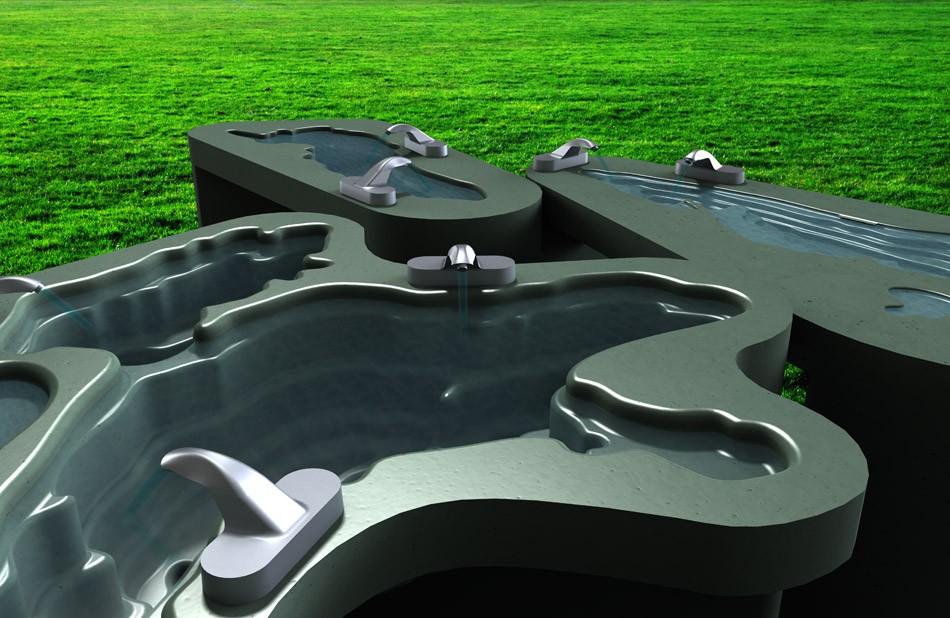During the last Super Bowl, an appeal to consider domestic water usage appeared as a halftime commercial from Colgate, in which a man kept the faucet running while he brushed his teeth. All the while, different hands reached in and out of the sink, filling cups, rinsing vegetables, and bringing hands full of the priceless liquid to mouths. Up to three gallons of water are wasted every time the tap is left open, the superimposed text declared.
In recent years, discussion about fresh water resources in the US has become more and more intense. While California is experiencing unprecedented drought, and its related fallout such as wildfires and water rationing, by comparison, our region is rich with fresh water resources ... at this moment.

- PHOTO PROVIDED
- Rochester Contemporary will kick off its Public Art Project with "What You Put In," an installation by Kevin Dartt.
This summer, Rochesterians will be asked to consider our individual impact on these resources, as Rochester Contemporary Art Center kicks off its new public art program with a water-centric installation by Kevin Dartt. The work, "What You Put In," will be a series of sinks in the shape of the Great Lakes, installed on the grounds of Christ Church next to RoCo.
Dartt says his goal with this work is "to break our complacency of abusing fresh water" by bringing the Great Lakes to a human scale. Because of our strong anthropocentric attitude, "individuals do not necessarily regulate their own actions toward the environment on a daily basis," he says. "With our large population little occurrences of land abuse add up."
The cast concrete sinks will not only take the scale and shape of each lake, the bowls of the sinks feature the real lakes' underwater topography as well. Faucets will continuously fill each sink with recirculating water as a reflection of our own domestic usage.
"It will be interesting to see how people will react" to the sculpture, Dartt says. "And if they chose to take care of this sculpture as a public space," Dartt says. "If garbage ends up in one of the 'lakes,' will a person clean it out or continue to add to it?"
This question is posed through the ambiguity of the title, "What You Put In," Dartt says. "Maybe we will find an invasive species in it one day, or as a fountain, people might throw coins in. In this regard the sculpture reflects how we are stewards of our own environment both public and private."
These particular lake-shaped forms have appeared in Dartt's work before; this work is a continuation of his Great Lakes Project. In the past, these topographical containers have manifested as prototypes for mop buckets, water-filtering carafes, and the net of a pool skimmer.
These consumer products interact with water in some manner, "scaled down to allow a person complete control over a large body of water," Dartt says.
Dartt earned a Master of Fine Art in Sculpture from Alfred University in 2015, and holds a Master of Science in Mechanical Engineering from Binghamton University. He has previous public art experience with his "Mt. Marcy Couch," an interactive piece of mountain-shaped furniture installed on the grounds of Governors Island in New York City.
That work juxtaposed domestic with environmental elements as well, and sought to confront "our transition from a society that has been predominantly living in the natural land to a culture that is constantly inside an artificial space," Dartt says in his artist statement.
"What You Put In" will remain installed from June 1 through September 30, and is accessible to the public free of charge, day and night. A picnic and artist talk will be held on site on July 14.
RoCo will start its public art project with two sculptures per year, with the hope to grow the scope over time. "We are always looking for new ways to foster creative energy here in Rochester," says RoCo Executive Director Blue Cease. "And I have been dreaming of a program of temporary sculpture for many years."
Each installation will remain on site for several months; some will directly relate to exhibitions held in the art center itself, while others will be presented in partnership with other organizations.
Future installations will be presented by a range of professional and emerging artists from Rochester and beyond, curated by RoCo and guests. RoCo will solicit future projects through a request for proposals from regional and national artists.